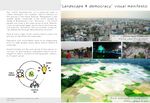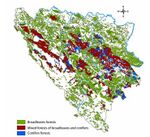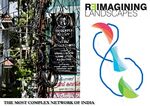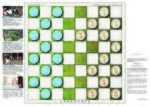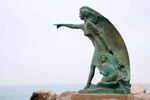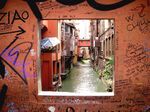LED Online Seminar 2019 - Working Group 5
--> Back to working group overview
Dear working group members. This is your group page and you will be completing the template gradually as we move through the seminar. Good luck and enjoy your collaboration!
Assignment 1 - Reading and Synthesizing Core Terminology
- You can read more details about this assignment here
- Readings are accessible via the resources page
Step 1: Your Landscape Democracy Manifestoes
Step 2: Define your readings
- Please add your readings selection for the terminology exercise before April 24:
A: Landscape and Democracy
B: Concepts of Participation
C: Community and Identity
D: Designing
E: Communicating a Vision
Steps 3 and 4: Concepts Selection and definition
- Each group member selects three relevant concepts derived from his/her readings and synthesize them/publish them on the wiki by May 15, 2019
- Group members reflect within their groups and define their chosen concepts into a shared definition to be posted on the wiki by June 12, 2019.
- Other group members will be able to comment on the definitions until June 30, 2019
- Each group will also report on their process to come to a set of shared definitions of key landscape democracy concepts on the wiki documentation until July 12, 2019
Concepts and definitions
Author 1: ...
- ......
- .......
- .......
Author 2: ...
- ......
- .......
- .......
Author 3: ...
- ......
- .......
- .......
Author 4: ...
- ......
- .......
- .......
Step 5: Reflection
Step 6: Revised manifestoes
- please look again at your initial manifestoes and update them with any new aspects/prespectives you have taken up during this seminar
Assignment 2 - Your Landscape Symbols
- You can read more details about this assignment here
Landscape Symbols Author 1: ...
- One of the historical park in Khulna city Bangladesh. In 1925 Mahatma Gandhi gave his speech in this park.
- Later after independence this park became unused, dirty place & a zone of criminal activity day by day.
- In 2011, Khulna City Corporation (KCC) took innitiative steps to intervent the park based on the demand of Khulna city people.
Landscape Symbols Author 2: ...
- === Landscape Symbols Author 4: ... ===
- Symbol yourname photovoice1
add a caption (one paragraph max) description of the symbolism, interpretation, as well as geo-location
- Symbol yourname photovoice2
add a caption (one paragraph max) description of the symbolism, interpretation, as well as geo-location
- Symbol yourname photovoice3
add a caption (one paragraph max) description of the symbolism, interpretation, as well as geo-location
Landscape Symbols Auther 3: ...
- === Landscape Symbols Author 4: ... ===
- Symbol yourname photovoice1
add a caption (one paragraph max) description of the symbolism, interpretation, as well as geo-location
- Symbol yourname photovoice2
add a caption (one paragraph max) description of the symbolism, interpretation, as well as geo-location
- Symbol yourname photovoice3
add a caption (one paragraph max) description of the symbolism, interpretation, as well as geo-location
Gianmarco Gianni
FISHERMAN WIFE - (44°04'54.6"N 12°34'36.2"E) In Rimini is possible to find this statue made of bronze, placed at the tip of the dock facing the open sea. The statue represent a woman with children on the shore waiting for her husband fishing in the sea. The scene is drammatic.The woman is aiming a point on the horizon trying to figure out where the husband fishing boat is, probably hoping to to see him coming back safely to the port. Till the XIX century this kind of risks were a big concern for families, in fact the sails of the fishing boats were all different from each other in order to make them recognizable from the shore. Each boat had its own particular sign on the sail, smartphones and GPS weren’t available back then. Fishing had always been part of Rimini's culture since it's on the coast, but in the last years it started losing its identity because of massive tourism from all over Europe. This sculpture wants to remember us our past, our origins, the respect for tough jobs such as fishing and most of all the respect for the sea as a force of nature and as a resource.
FINESTRELLA DI VIA PIELLA - (44°29'54.8"N 11°20'43.1"E)The Finestrella from Bologna can be considered as a symbol because it gives us a view from the past and remember us that we should preserve our environment and cultural background against an easy and irresponsible progress. Bologna between the XIII and XVII century was famous for the production of fabrics made of silk and had 15 watermills that were providing energy to move the mules. These watermills were powered by many rivers passing through the city. The city should’ve looked like an inland Venice. During the ‘50s the local administration decided to cover all the rivers and to release wastewater into them in the name of a quick progress. Since that moment Bologna changed completely its aspect. Only in 1998 the local administration started a new project with the intent to regain that lost beauty. The river we can see through the window is the Fiume Reno that was uncovered and cleaned from the dirt. Moreover the small window was placed to create an inspiring point of view and to give the sense of what it should’ve been.
BOLOGNA’S URBAN FABRIC - (44°29'37.9"N 11°20'33.8"E) Bologna itself and its urban fabric can be considered as a landscape symbol because, despite its monuments and so on, the main aspect that makes Bologna stand in the comparison with other cities is its urban planning. The will to preserve its medieval pattern throughout the centuries had always been part of citizens sensibilities. This includes materials, colours and many other features. Meanwhile in Europe at the end of the XIX century was developing a sense of discard to the past urban set up, Bologna instead found its own way to renew itself respecting its origins. The best way to experience Bologna in fact is to take a walk around the city center, enjoy its porches and be amazed by the continuity of its glimpses despite built in different periods.
Assignment 3 - Role Play on Landscape Democracy "movers and shakers"
- You can read more details about this assignment here
Assignment 4 - Your Landscape Democracy Challenge
- You can read more details about this assignment here
- Each group member will specify a landscape democracy challenge in his/her environment
Landscape Democracy Challenge 1
- Give a title to your challenge
- Yourname challenge 1.jpg
caption: why did you select this case?
- Yourname challenge 2.jpg
caption: what is the issue/conflict (1)
- Yourname challenge 3.jpg
caption: what is the issue/conflict (2)
- Yourname challenge 4.jpg
caption: who are the actors?
Your references:
- ...
- ...
Landscape Democracy Challenge 2
- Give a title to your challenge
- Yourname challenge 1.jpg
caption: why did you select this case?
- Yourname challenge 2.jpg
caption: what is the issue/conflict (1)
- Yourname challenge 3.jpg
caption: what is the issue/conflict (2)
- Yourname challenge 4.jpg
caption: who are the actors?
Your references:
- ...
- ...
Landscape Democracy Challenge 3
- Give a title to your challenge
- Yourname challenge 1.jpg
caption: why did you select this case?
- Yourname challenge 2.jpg
caption: what is the issue/conflict (1)
- Yourname challenge 3.jpg
caption: what is the issue/conflict (2)
- Yourname challenge 4.jpg
caption: who are the actors?
Your references:
- ...
- ...
Landscape Democracy Challenge 4
- Give a title to your challenge
- Yourname challenge 1.jpg
caption: why did you select this case?
- Yourname challenge 2.jpg
caption: what is the issue/conflict (1)
- Yourname challenge 3.jpg
caption: what is the issue/conflict (2)
- Yourname challenge 4.jpg
caption: who are the actors?
Your references:
- ...
- ...
Your Democratic Change Process
- Add Title
- Your Democratic Change Process Slide1.jpg
caption: ...
- Your Democratic Change Process Slide2.jpg
caption: ...
- Your Democratic Change Process Slide3.jpg
caption: ...
- Your Democratic Change Process Slide4.jpg
caption: ...
Reflection
- ....
- ....
- ....
Conclusion:
- ....
- ....
- ....
Your references
- ...
- ...
- ...
